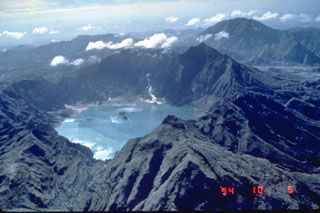Report on Pinatubo (Philippines) — July 1992
Bulletin of the Global Volcanism Network, vol. 17, no. 7 (July 1992)
Managing Editor: Lindsay McClelland.
Pinatubo (Philippines) Continued dome growth; officials warn of possible explosive eruption
Please cite this report as:
Global Volcanism Program, 1992. Report on Pinatubo (Philippines) (McClelland, L., ed.). Bulletin of the Global Volcanism Network, 17:7. Smithsonian Institution. https://doi.org/10.5479/si.GVP.BGVN199207-273083
Pinatubo
Philippines
15.13°N, 120.35°E; summit elev. 1486 m
All times are local (unless otherwise noted)
The lava dome in the center of the caldera lake was continuing to grow as of mid-August. Periods of increased seismicity and decreased gas emission prompted an official warning of possible renewed explosive activity, but none had occurred at press time. Rain-induced lahars and secondary explosions from the pyroclastic-flow deposits continued with the ongoing rainy season.
By late July, the lava dome was 250 m across and 75 m high in the center of the 600 x 800 m crater lake. Lake depth was estimated at < 5 m. COSPEC measurements on 21 July indicated an SO2 emission rate of 900 ± 200 metric tons/day (t/d). Secondary explosions from the 1991 pyroclastic-flow deposits occurred daily, producing columns that sometimes reached 7.5 km altitude. Secondary pyroclastic flows were triggered in the Pasig-Potrero and Marella drainages. Daily lahars were filling channels below 100 m elevation. Seismicity was dominated by high-frequency events, but long-period events and tremor occurred roughly once a day in episodes that lasted up to an hour. Maximum tremor amplitude was 4-5 mm peak-to-peak.
A systematic increase in low-frequency seismicity started at the beginning of August. Earthquake counts reached 125 low-frequency and 41 high-frequency events during the 24 hours ending at 0600 on 10 August. A newly installed seismic station near the N rim of the caldera detected numerous signals reminiscent of those recorded at a similar site 3-4 days before the onset of the 1991 explosive eruption. SO2 emission dropped from 830 t/d on 3 August to 250 t/d on 6 August, and remained at relatively low levels. A similar decrease had occurred several days before the 1991 explosions. Because of these changes, PHIVOLCS warned of the threat of another explosive eruption within a week or less, but noted that explosions comparable to those of 15 June 1991 were not anticipated. People were strongly urged to avoid the official danger zone that extends in a 10-km radius from the crater. No population centers are within the danger zone, but about 2,000 people living nearby sought refuge in government evacuation centers.
An aerial survey on 10 August revealed additional growth of the dome, to about 300 m in diameter and 100 m high. Uplift of some 2 m had produced a beach about 30 m wide against the dome's N flank. By the next day the beach front was 50 m from the edge of the dome, and it had advanced an additional 5 m outward by 12 August. Gas rose to several hundred meters above the crater rim. The rate of SO2 emission had declined to about 200 t/d by 7 August and was about the same on 11 August.
Geological Summary. Prior to 1991 Pinatubo volcano was a relatively unknown, heavily forested lava dome complex located 100 km NW of Manila with no records of historical eruptions. The 1991 eruption, one of the world's largest of the 20th century, ejected massive amounts of tephra and produced voluminous pyroclastic flows, forming a small, 2.5-km-wide summit caldera whose floor is now covered by a lake. Caldera formation lowered the height of the summit by more than 300 m. Although the eruption caused hundreds of fatalities and major damage with severe social and economic impact, successful monitoring efforts greatly reduced the number of fatalities. Widespread lahars that redistributed products of the 1991 eruption have continued to cause severe disruption. Previous major eruptive periods, interrupted by lengthy quiescent periods, have produced pyroclastic flows and lahars that were even more extensive than in 1991.
Information Contacts: PHIVOLCS; Reuters.

